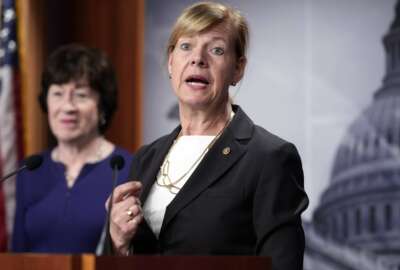Hubbard Radio Washington DC, LLC. All rights reserved. This website is not intended for users located within the European Economic Area.
OMB unveils ambitious digital, mobile strategy
The administration will release its Digital Management Strategy today that details 29 goals with deadlines over the next 12 months. OMB wants to set up a FedRAM...
wfedstaff | April 17, 2015 3:46 pm
The story was updated at 12:11 p.m. May 23 to include comments from Federal CIO Steven VanRoekel.
The Office of Management and Budget laid out an ambitious plan to institutionalize and standardize the mobile evolution.
In its Digital Management Strategy released today, the administration set 29 different goals for agencies with deadlines for each over the next 12 months, including the creation of a FedRAMP for mobile effort and a new innovation center run by the General Services Administration.
“Operationalizing an information-centric model, we can architect our systems for interoperability and openness, modernize our content publication model, and deliver better, device-agnostic digital services at a lower cost,” OMB stated in the strategy. “Learning from the previous transition of moving information and services online, we now have an opportunity to break free from the inefficient, costly, and fragmented practices of the past, build a sound governance structure for digital services, and do mobile ‘right’ from the beginning.”
And “doing mobile right from the beginning” means using application programming interfaces (APIs) with all new systems to focus on the data and not the devices. It means prioritizing existing systems to apply APIs to expose data more easily. Finally, it means using shared services, doing customer focus groups and ensuring security and privacy are built into any mobile or digital system from the beginning.
“To lay the foundation for opening data and content efficiently, effectively and accessibly, OMB will work with representatives from across government to develop and publish an open data, content and Web API policy for the federal government,” the strategy stated. “This policy will leverage central coordination and leadership to develop guidelines, standards and best practices for improved interoperability. To establish a ‘new default,’ the policy will require that newly developed IT systems are architected for openness and expose high-value data and content as Web APIs at a discrete and digestible level of granularity with metadata tags.”
OMB released its draft digital strategy in January as a combined mobile and .gov Website reform plan. The administration said it received more than 570 ideas and 2,000 comments on the two documents.
Federal Chief Information Officer Steven VanRoekel and Federal Chief Technology Officer Todd Park discussed the new strategy today in New York City at the TechCrunch event. VanRoekel put the strategy on a fast track in January. He said in January that the government must do a better job in keeping pace with industry and public expectations.
“This is a roadmap by which we will transform government to become this enablement platform, to unleash data and to unlock potential that sits locked up in these PDF files and paper and in these archaic systems on the backend. The key tenets to this data is open data is the new default,” VanRoekel said. “As we collect, use and disseminate data, we will make it open. We will buy IT and we are going to invest in technology that ensures as we do that collection, as we do that use and as we do that dissemination, that it is open by default and when appropriate, public by default.”
VanRoekel said everything is driving toward a screen size and vendor agnostics approach so it works anywhere, at anytime.
Along with the strategy, President Barack Obama issued a memo to agency heads requiring them to implement the plan within 12 months and within 90 days create a website to publicly report progress in meeting the requirements.
The new strategy is guided by three objectives:
- Enabling citizens to access high quality, digital government information and services anywhere, at anytime and from any device.
- Ensure the government buys and manages mobile devices, applications and data in a smart and secure way.
- Spur innovation by making data accessible and easy to use to improve the quality of services to citizens.
VanRoekel said as part of the strategy OMB is freezing any new .gov domain websites.
“We will have a very laborious process to go through for health or safety reasons if someone needs .gov domain, but other than that, we will stop the growth of when I started this job 1,800 .gov domains and 40,000 to 50,000 websites,” he said. “That’s got to stop.”
VanRoekel said the goal is to change the way the government and citizens interact.
“We are going to make government data social. We are going to focus on the aspects on how do we take this data and drive interaction. Not just as a government as a communication platform, which is typically what we’ve done across our 450 million pages of websites in the footprint, but how do we drive that down to make this social so we not only communicate, but we have a two-way interaction,” he said.
Over the next three months, agencies will bring together C-Level executives, digital strategists, Web managers, data managers and geographic information officers to identify three-high priority legacy systems to move into the digital/mobile environment.
Tom Suder, president of Mobilegov and co-chairman of the Advanced Mobility Working Group at ACT/IAC, said the strategy pushes the government down a smart path.
“It’s a great first step to come up with common APIs for systems. It will help develop mobile,” he said. “The mobile version of FedRAMP is another good idea because instead of everyone developing security protocols in silos, it will speed development of mobile. Those are the two biggest things in the whole strategy.”
The mobile version FedRAMP will be led by the departments of Homeland Security and Defense and the National Institute of Standards of Technology.
The three agencies will develop a mobile/digital security platform over the next 12 months.
“This will include the development of mobile and wireless security reference architectures that incorporate security and privacy by design while accounting for different agencies’ mission needs,” the OMB strategy stated. “A governmentwide mobile and wireless security baseline will enable adoption of the ‘do once, use many times’ approach to mobile and wireless security assessment, authorization, and continuous monitoring.”
Additionally, the Federal Chief Information Officer’s Council will work with NIST and the National Archives and Records Administration to develop privacy control guidelines for the digital environment.
The Federal CIO Council’s Privacy Committee will work with NIST and the National Archives and Records Administration (NARA) to develop guidelines to implement standard privacy controls in a digital environment and educate key agency privacy and legal officials on the latest technology advances and options for addressing digital privacy as well as records retention and security issues.
New innovation center
The Digital Services Innovation Center will focus on three areas, including identifying shared and open content management system (CMS), helping to develop APIs and launching a shared mobile application development program.
The mobile application development program will be done “in conjunction with the Federal CIO Council that will help agencies develop secure, device-agnostic mobile applications, provide a development test environment to streamline app delivery, foster code-sharing, and validate official government applications.”
Along with the innovation center, OMB will create a Digital Services Advisory Group led by the CIO Council, the federal Web Managers Council and other agency leaders.
“[T]he advisory group will promote cross-agency sharing and accelerated adoption of mobile workforce solutions and best practices in the development and delivery of digital services that build in security and privacy and keep the federal workforce abreast of emerging technologies,” the strategy stated. “The Digital Services Advisory Group will recommend guidelines to help agencies set up an effective governance structure where it does not yet exist. The guidance will suggest a range of approaches, but not prescribe specific structures, and set expectations for activities and outcomes.”
OMB stated the guidelines will include helping to establish new governance structures or strengthen existing ones, and establishing specific, measurable goals for delivering better services at a lower cost.
The advisory group also will work with the CIO Council to develop models for secure and rapid delivery of commercial mobile applications, which are based on consistent security and interoperability standards.
RELATED STORIES:
White House looking for a few ‘bad asses’ to kick-start 5 projects
OMB evolving mobile strategy as focus broadens
Website reform task force gets marching orders
VanRoekel puts mobile strategy on fast track
Copyright © 2024 Federal News Network. All rights reserved. This website is not intended for users located within the European Economic Area.
Jason Miller
Jason Miller is executive editor of Federal News Network and directs news coverage on the people, policy and programs of the federal government.
Follow @jmillerWFED
-
Don’t look now, but your TSP is swooning Federal Drive
-
DoD gets serious about technology transfer to the troops Federal Drive





